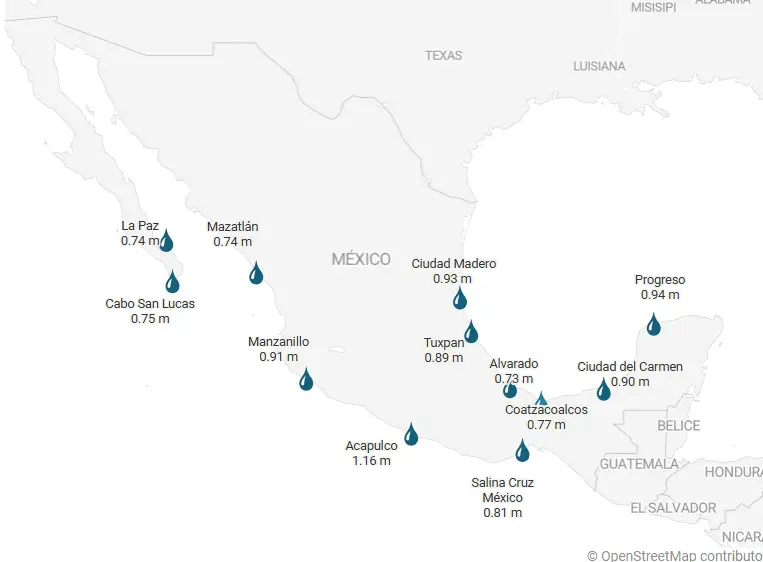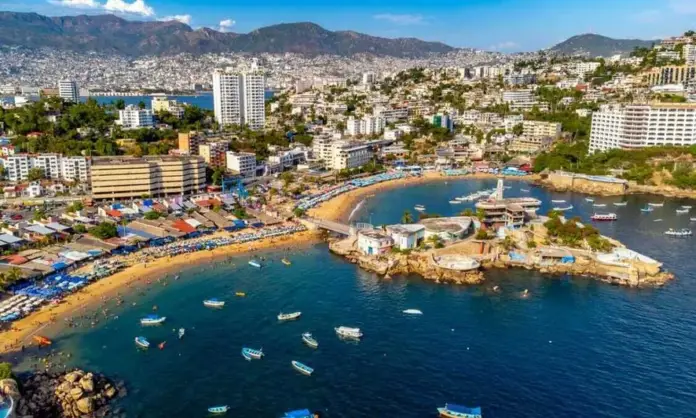Every Easter, Mexican beaches fill with tourists. Cities like Acapulco and Cabo San Lucas are overwhelmed by bathers seeking to cool off in the sea.
The landscape you see today is far from what it was fifty or one hundred years ago; what you see today may also disappear for future generations. Those who visit 75 years from now could witness the drastic change projected by a tool developed by NASA.
The platform, called Sea Level Projection, was designed to calculate sea level rise based on predictions from the UN’s Intergovernmental Panel on Climate Change and fed with data spanning nearly two decades (from 1995 to 2024). The tool calculates the possible sea level rise in the next 75, 85, 95, 105, 115, and 125 years.
What will happen to the beaches as we know them?
The platform shows rising sea levels at different points around the world, taking into account the role of water temperature and the level of future greenhouse gas emissions.
Heat influences the behavior of the ocean. On the one hand, it expands it (a phenomenon known as thermal expansion). On the other hand, it fuels it, contributing to the melting of glaciers. Although its exact effect is unknown, NASA scientists designed different scenarios.
The regions most at risk worldwide are concentrated in the eastern United States; however, they are not the only ones on the list. By 2100, 14 beaches in Mexico will be transformed, as part of their land could be reclaimed by the sea if greenhouse gas emissions continue to be high.
With this in mind, the platform’s data indicates that over the next 75 years, sea level will rise as follows:
Ensenada: 0.60 meters
Cabo San Lucas: 0.67 meters
La Paz: 0.74 meters
Guaymas: 0.80 meters
Mazatlán: 0.74 meters
Manzanillo: 0.91 meters
Acapulco: 1.16 meters
Salina Cruz: 0.81 meters
Progreso: 0.94 meters
Ciudad del Carmen: 0.90 meters
Coatzacoalcos: 0.77 meters
Alvarado: 0.73 meters
Tuxpan: 0.89 meters
Ciudad Madero: 0.93 meters
In mid-March of this year, a NASA analysis found that global sea level rose faster than expected during 2024. The increase was 0.59 centimeters. when it was expected to be 0.43 centimeters per year.
According to Josh Willis, a researcher at the US space agency, although growth varies slightly each year, specialists have noticed that the sea level continues to rise, and is rising more rapidly.
In addition to studies conducted by NASA, various investigations warn about the consequences of ocean warming for Mexico, whose coastline stretches more than 15,000 kilometers.
In mid-March of this year, the roundtable “Arctic and Antarctica: Experiences in Glaciers” was held, sponsored by the National Autonomous University of Mexico (UNAM). Patricia Valdespino Castillo, professor at the National School of Earth Sciences, warned about the impact of melting glaciers in Mexico.
The expert asserted that, despite being thousands of kilometers away, the warming of Antarctica increases the likelihood of flooding and saltwater intrusion in Mexican territory, especially on the coasts of Veracruz, the Yucatan Peninsula, and the coasts of Campeche, Tabasco, and Quintana Roo, states known for their tourist destinations.

What will sea level rise be like? There is a precedent in Tabasco
Mexico is the fifth most vulnerable country in the world to disasters and extreme natural phenomena, including those caused by climate change, according to the World Risk Reports 2024.
Proof of this is Hurricane Otis, which displaced 187,000 people from their homes, making it the tropical cyclone that has caused the most displacement in Mexico, according to the Global Report on Internal Displacement.
However, despite the scope of the meteorological phenomenon, it is not the first major disaster associated with climate change to force people to abandon their homes.
El Bosque, a fishing village located in Tabasco, could be a mirror for future coastal cities, as it is considered the first community in the country to experience the direct consequences of the climate crisis: the sea swallowed part of what it once was.
According to an investigation conducted by reporter Miguel Fernando Valle, as of November 2022, the sea had destroyed a total of 29 homes, out of the approximately 90 in the area. However, various media outlets have reported that over time, the number of affected properties continues to grow.
NGOs such as GreenPeace, Conexiones Climáticas, and Nuestro Futuro have declared El Bosque the first region in the entire country (for which there is an official record) where its inhabitants have been forced into displacement due to climate change, more specifically, rising sea levels.

Source: milenio




